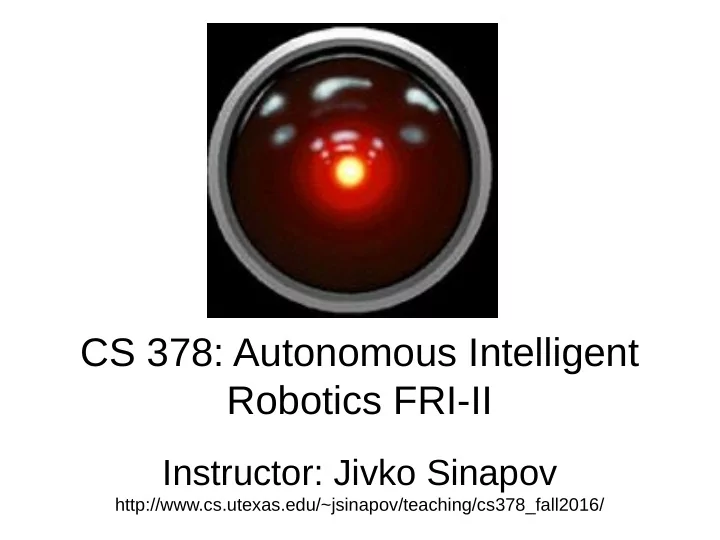

CS 378: Autonomous Intelligent Robotics FRI-II Instructor: Jivko Sinapov http://www.cs.utexas.edu/~jsinapov/teaching/cs378_fall2016/
Reinforcement Learning (Part 2)
Announcements
Volunteers needed for robot study Sign up sheet here: https://docs.google.com/spreadsheets/d/1Gr 2GqlPt8kdTJwlZ3FerxU0J8oIoGt0pEbeR37iCHqY/ edit#gid=0 Further details will be made available on Canvas via an announcement
FAI Talk this Friday “Turning Assistive Machines into Assistive Robots” Brenna Argall Northwestern University Friday, Sept. 9 th , 11 am @ GDC 6.302 [ https://www.cs.utexas.edu/~ai-lab/fai/ ] or google “fai ut cs”
Robotics Seminar Series Talk “Learning from and about humans using an autonomous multi-robot mobile platform” Jivko Sinapov UT Austin Wed., Sept. 7 th , 3 pm @ GDC 5.302
Robot Training ● Sign up for a robot training session next week at: https://docs.google.com/spreadsheets/d/1kz6QMPa-xkdFQNyV 0Biif913JKf73GIUGx9bVSLo_R8/edit?usp=sharing ● Link will be posted as Announcement on Canvas
Preliminary Project “Presentations” ● Date: September 13 th ● Form groups of 2-3 prior to the date ● Be prepared to talk about 2-3 project ideas for 5-10 minutes ● Email me your group info, i.e., who is in it
Project Ideas
Project Idea: Improve the robot's grasping ability ● Currently, the robot does not “remember” which grasps succeeded and which failed ● If the robot were to log the context of the grasp (e.g., the position of the gripper relative to the object's point cloud) and the outcome, it could incrementally learn a model to predict the outcome given the context ● The robot's current grasping software is described in http://wiki.ros.org/agile_grasp
Project Idea: Object Handover ● Currently, the arm can let go of an object or close its fingers upon sufficient contact using haptic feedback ● Can you make it so that it can move towards an object held by a human and grasp it based on visual and haptic feedback?
Project Idea: Learning about objects from humans ● The robot is currently able to grasp an object from a table and navigate to an office ● Can we use the GUI to ask humans questions about objects and store this information in a database that can be used for learning recognition models?
Project Idea: Large-Scale 3D object mapping ● Can we combine 3D Plane detection and Clustering to detect and map objects in the environment?
Project Idea: Learning an object manipulation skill ● Example: Pressing a button
Project Idea: Enhance Virtour www.cs.utexas.edu/~larg/bwi_virtour
Reinforcement Learning (Part 2)
Markov Decision Process (MDP)
Markov Decision Process (MDP) The reward and state-transition observed at time t after picking action a in state s is independent of anything that happened before time t
Maze World [slide credit: David Silver]
Maze World State Representation: Factored vs. Tabula Rasa [slide credit: David Silver]
Maze Example: Policy [slide credit: David Silver]
Maze Example: Value Function [slide credit: David Silver]
Maze Example: Policy [slide credit: David Silver]
Maze Example: Model [slide credit: David Silver]
Sparse vs. Dense Reward
Notation and Problem Formulation ● Overview of notation in TEXPLORE paper
Notation Set of States: Set of Actions: Transition Function: Reward Function:
Action-Value Function
Action-Value Function Probability of going to Discount factor state s' from s after a (between 0 and 1) The value of taking a' is the action with action a in state s the highest action- value in state s' The reward received after taking action a in state s
Action-Value Function Common algorithms to learn the action-value function include Q-Learning and SARSA The policy consists of always taking the action that maximize the action-value function
Q-Learning Grid World Example https://www-s.acm.illinois.edu/sigart/docs/QLearning.pdf
RL in a nutshell
RL in a nutshell
Q-Learning ● Guest Slides
Pac Man Example
Linear Function Approximator of Q* Φ (s,a) = x where x is an n -dimensional feature vector Q* (Φ (s,a) ) = w 1 * x 1 + w 2 * x 2 + … + w n * x n
How does Pac-Man “see” the world?
How does Pac-Man “see” the world?
How does Pac-Man “see” the world?
Linear Function Approximator of Q* Φ (s,a) = x where x is an n -dimensional feature vector Q* (Φ (s,a) ) = w 1 * x 1 + w 2 * x 2 + … + w n * x n The task now is to find the optimal weight vector w
Can RL learn directly from images? ● Yes it can: ● http://karpathy.github.io/2016/05/31/rl/
Video on Updating a NN's Weights Neural Networks Demystified [Part 3: Gradient Descent] https://www.youtube.com/watch?v=5u0jaA3qAGk
Video of TAMER http://labcast.media.mit.edu/?p=300
Using RL: Essential Steps 1) Specify the state space or the state-action space – Are the states and/or actions discrete or continous? 2) Specify the reward function – If you have control over this, dense reward is better than sparse reward 3) Specify the environment (e.g., a simulator or perhaps the real world) 4) Pick your favorite RL algorithm that can handle the state and action representation
Resources ● BURLAP: Java RL Library: http://burlap.cs.brown.edu/ ● Reinforcement Learning: An Introduction http://people.inf.elte.hu/lorincz/Files/RL_2 006/SuttonBook.pdf
Recommend
More recommend